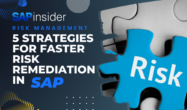SAP Risk Management
Filter By
Browse By
- SAP Analytics and AI
- SAP Application Development and Integration
- All SAP Application Development and Integration
- SAP ABAP
- SAP ABAP Development Tools
- SAP ABAP Test Cockpit
- SAP API Management
- SAP BAPI
- SAP Basis
- SAP BRF
- SAP Business Application Studio
- SAP CMS
- SAP Design Studio
- SAP Development Tools
- SAP DevOps
- SAP EAI
- SAP EDI
- SAP Extension Suite
- SAP Fiori
- SAP Fiori Elements
- SAP Integration Suite
- SAP Low Code Application Development
- SAP Low Code Automation
- SAP Netweaver
- SAP Release Management
- SAP UI5
- SAP Web Application Server
- SAP Web IDE
- SAP Business Process Management
- SAP Center of Excellence
- SAP CIO
- SAP Customer Experience
- SAP Data and Data Management
- All SAP Data and Data Management
- SAP BW
- SAP BW/4HANA
- SAP Crystal Reporting
- SAP Data Archiving
- SAP Data Center
- SAP Data Governance
- SAP Data Integration
- SAP Data Migration
- SAP Data Quality
- SAP Data Services
- SAP Data Strategy
- SAP Data Visualization
- SAP Data Warehouse Cloud
- SAP DMS
- SAP Document Control
- SAP EIM
- SAP ETL
- SAP ETL Tools
- SAP HANA
- SAP HANA Administration
- SAP HANA Deployment Infrastructure
- SAP HANA Studio
- SAP Master Data
- SAP Master Data Governance
- SAP MDM
- SAP Enterprise Architect
- SAP Enterprise Asset Management
- SAP ERP
- SAP Finance
- All SAP Finance
- SAP Accounting
- SAP AR AP
- SAP Asset Accounting
- SAP Billing Systems
- SAP BPC
- SAP BRIM
- SAP Cash Management
- SAP Central Finance
- SAP Controlling
- SAP COPA
- SAP Cost Center Accounting
- SAP e-invoicing
- SAP FICO
- SAP Finance Automation
- SAP Financial Closing Cockpit
- SAP Financial Consolidation
- SAP Financial Planning
- SAP FX Risk
- SAP General Ledger
- SAP Global Tax Management
- SAP Hyperion
- SAP Order to Cash
- SAP Payment Processing
- SAP Profitability Analysis
- SAP Rebate Management
- SAP S/4HANA Finance
- SAP Universal Journal
- SAP Governance Risk and Compliance
- SAP Human Capital Management
- SAP Intelligent Technologies
- SAP Platform and Technology
- All SAP Platform and Technology
- SAP Business Technology Platform
- SAP Cloud Connector
- SAP Cloud Integration Platform
- SAP Cloud Migration
- SAP Cloud Platform
- SAP Cloud Providers
- SAP Cloud Strategy
- SAP Container Platform
- SAP Digital Asset Management
- SAP Digital Integration Hub
- SAP Digital Signature
- SAP HANA Enterprise Cloud
- SAP HEC
- SAP Hyperscalers
- SAP Infrastructure
- SAP Messaging
- SAP Smart Forms
- SAP Quality and Testing
- SAP Security
- SAP Spend Management
- SAP Supply Chain Management
- All SAP Supply Chain Management
- SAP APO
- SAP Asset Management
- SAP Business Network
- SAP Digital Manufacturing Cloud
- SAP Digital Twin
- SAP EWM
- SAP IBP
- SAP Inventory Management
- SAP Label Printing
- SAP Logistics
- SAP Manufacturing
- SAP Manufacturing Automation
- SAP MES
- SAP MII
- SAP MM
- SAP MRO
- SAP MRP
- SAP Order Management
- SAP Plant Maintenance
- SAP PLM
- SAP Production Planning
- SAP S&OP
- SAP SD
- SAP SPM
- SAP Supply Chain Planning
- SAP Track and Trace
- SAP Transportation Management
- SAP System Administration
What is SAP Risk Management?
Risk management for a business isn’t just about identifying and eliminating areas of risk. For many organizations, it’s also about making decisions on acceptable levels of risk and establishing hierarchies of risk — what needs to be immediately dealt with and what can wait. Keeping track of all organizational risk in a centralized way makes it easier for companies to analyze risk impacts — this type of centralization is often enabled by technology. SAP Risk Management is one risk management tool within the SAP Governance, Risk, and Compliance (GRC) suite that supports risk identification, assessment, analysis, and monitoring.
What is SAP Risk Management?
Risk management for a business isn’t just about identifying and eliminating areas of risk. For many organizations, it’s also about making decisions on acceptable levels of risk and establishing hierarchies of risk — what needs to be immediately dealt with and what can wait. Keeping track of all organizational risk in a centralized way makes it easier for companies to analyze risk impacts — this type of centralization is often enabled by technology. SAP Risk Management is one risk management tool within the SAP Governance, Risk, and Compliance (GRC) suite that supports risk identification, assessment, analysis, and monitoring.
Risk management tools like SAP Risk Management often provide better visibility into organizational risk and bring together various types of risk into a single place for monitoring. Risk management solutions may include the following features, among others:
- Risk strategy and planning
- Risk identification
- Risk analysis
- Risk monitoring
- Dashboards and graphical views
- Real-time and automated risk monitoring
- Guided workflows to enforce governance rules
There are many sources of risk in an organization, and some vendors provide solutions to address various risk elements. For example, Appsian Security offers tools that bolster risk monitoring around financial transactions. Fastpath offers risk management solutions that focus on multiple areas of risk, including segregation of duties, regulatory compliance, and access risk. RSM’s toolset provides process automation around risk management.
Key Considerations for SAPinsiders:
- Risk events are rising, compounding the need for better risk monitoring and anticipation. Legacy tools and business models don’t typically offer the capabilities needed to properly manage risk in a centralized place. To fix this, companies are now including risk management as part of their digital transformation activities, implementing intelligent technologies and robotic process automation to help improve risk management and other GRC functions.
- GRC teams are stretched, according to our latest research on the state of the GRC market. The most successful organizations are taking pressure off GRC professionals with automation. You should look to automate risk management wherever possible — it’s best for repeatable processes. Risk management tools that automate risk monitoring and reporting reduce manual labor for GRC staff and free them up to do more strategy and planning.
- You can improve risk strategy and decision making across the entire company, from operations through audit, with risk-aware, risk-adjusted management. You should work toward this goal with strategies such as risk training for line-of-business users and by creating an interdisciplinary risk management committee.
16 results
-

- SAP Risk Management
 Premium
Premium
Things that Go Bump in the Night: What your Admins are up to when You aren’t Looking
SAP administrators are often thought of as gatekeepers who hold the keys to accessing a company’s SAP systems. While they often prevent users from gaining access to sensitive information, their own position comes with risks that they themselves could commit security breaches. In this session, we will discuss the different ways SAP admins expose your…
-

5 Strategies for Faster Risk Remediation in SAP
Published: 08/October/2020
Reading time: 3 mins
If left undone, remediating access risks can be tedious, time-consuming, and even costly. Companies can avoid running into these negative consequences by viewing remediation tasks as necessary and approaching them with the same urgency they would apply to discovering violations. This blog post explains 5 strategies to help reduce remediation work. Read this blog post…
-

GRC: Case study: How Honeywell increased risk visibility and improved efficiency with its enterprise risk and controls strategy
Published: 10/March/2019
Reading time: 1 mins
Learn how Honeywell has driven standardization of controls and processes, improved efficiency, reduced costs, and increased organizational risk visibility using SAP Process Control and SAP Risk Management. Click this link to view the slides from this session — GRC2017_Chirico_Casestudyhowhoneywell_V2. Karen Chirico If you have comments about this article or publication, or would like to...…
-
-

Global Law Firm Motions to Eliminate Risk
Published: 27/November/2017
Reading time: 8 mins
Managing risk and keeping controls in place are important concepts for companies of all shapes and sizes — not just public companies needing to comply with Sarbanes-Oxley. Linklaters, a private, global law firm, felt these challenges first-hand after spending too long cobbling together external spreadsheets and manual processes to track access among users distributed around…
-

How to Use the SAP DLL Framework to Synchronize Foreign Exchange Rates from ECC to SAP Insurance Analyzer
Published: 02/June/2016
Reading time: 7 mins
Learn how to develop an end-to-end process to synchronize market data foreign exchange (FX) rates in SAP Insurance Analyzer from SAP ERP Central Component (ECC) using the Data Load Layer (DLL). Key Concept Data Load Layer (DLL) is the new strategic framework to update market data, such as exchange rates and interest rates, the Source...…
-

How to Define Position Management Procedures in SAP Treasury and Risk Management
Published: 03/February/2016
Reading time: 14 mins
Learn how to define and use the position management procedures in SAP Treasury and Risk Management to determine the sequence of steps for generating a derived business transaction. Key Concept SAP Treasury and Risk Management is a series of solutions geared toward analyzing and enhancing business processes in the finance area of a company. In...…
Become a Member
Unlimited access to thousands of resources for SAP-specific expertise that can only be found here.
Related Vendors
Your request has been successfully sent

